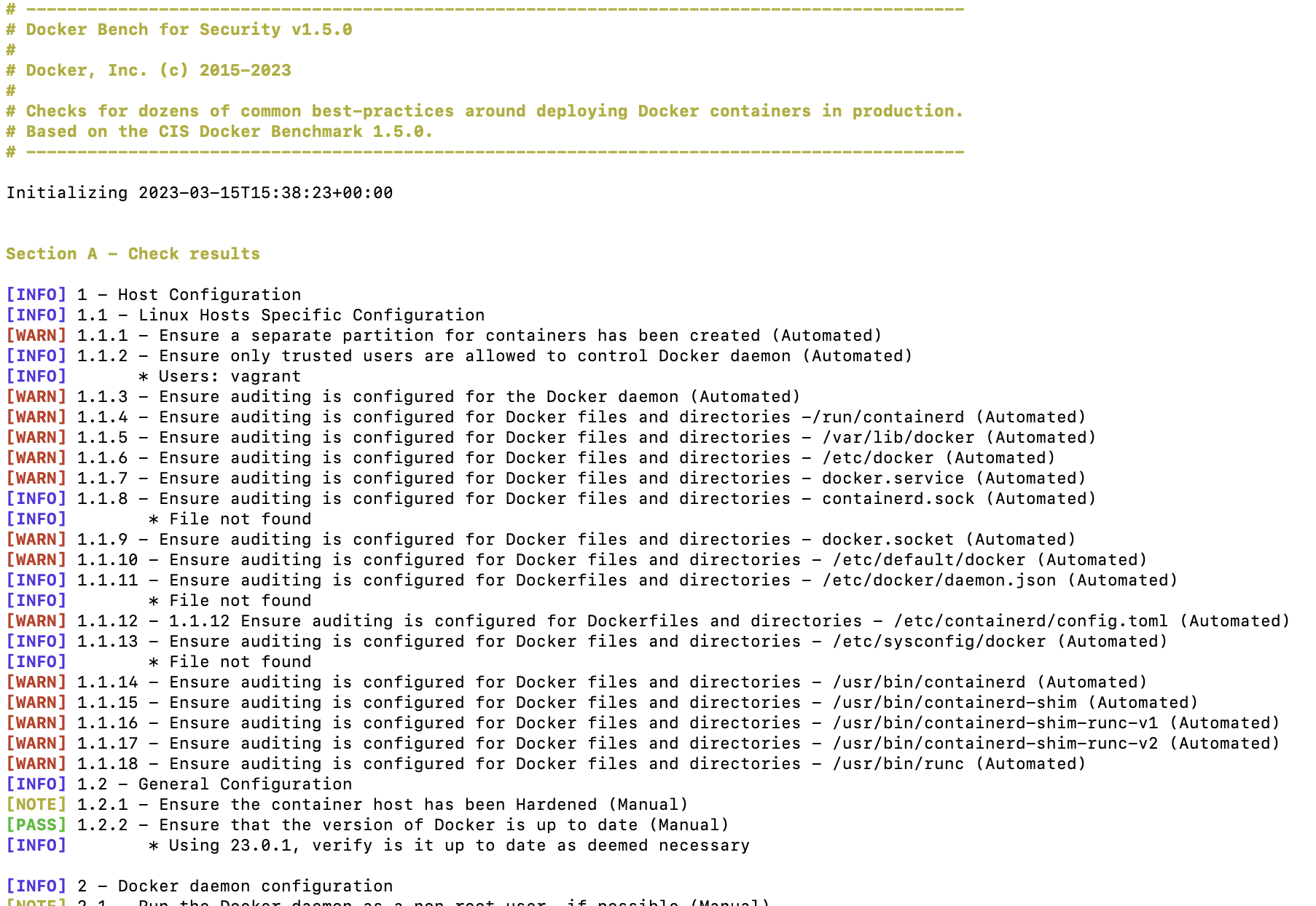|
|
||
|---|---|---|
| .github/workflows | ||
| functions | ||
| img | ||
| tests | ||
| .dockerignore | ||
| .gitignore | ||
| CONTRIBUTING.md | ||
| CONTRIBUTORS.md | ||
| docker-bench-security.sh | ||
| docker-compose.yml | ||
| Dockerfile | ||
| LICENSE.md | ||
| MAINTAINERS | ||
| README.md | ||
| Vagrantfile | ||
Docker Bench for Security
The Docker Bench for Security is a script that checks for dozens of common best-practices around deploying Docker containers in production. The tests are all automated, and are based on the CIS Docker Benchmark v1.6.0.
We are making this available as an open-source utility so the Docker community can have an easy way to self-assess their hosts and Docker containers against this benchmark.
| Release | CIS |
|---|---|
| 1.6.0 | 1.6.0 |
| 1.5.0 | 1.5.0 |
| 1.3.6 | 1.4.0 |
| 1.3.5 | 1.2.0 |
| 1.3.3 | 1.1.0 |
| 1.3.0 | 1.13.0 |
Running Docker Bench for Security
Run from your base host
You can simply run this script from your base host by running:
git clone https://github.com/docker/docker-bench-security.git
cd docker-bench-security
sudo sh docker-bench-security.sh
Note:
jqis an optional but recommended dependency.
Run with Docker
Building Docker image
You have two options if you wish to build and run this container yourself:
- Use Docker Build:
git clone https://github.com/docker/docker-bench-security.git
cd docker-bench-security
docker build --no-cache -t docker-bench-security .
Followed by an appropriate docker run command as stated below.
- Use Docker Compose:
git clone https://github.com/docker/docker-bench-security.git
cd docker-bench-security
docker-compose run --rm docker-bench-security
Please note that the docker/docker-bench-security image is out-of-date and and a manual build is required. See #405 for more information.
Note that this container is being run with a lot of privilege -- sharing the host's filesystem, pid and network namespaces, due to portions of the benchmark applying to the running host.
Using the container
docker run --rm --net host --pid host --userns host --cap-add audit_control \
-e DOCKER_CONTENT_TRUST=$DOCKER_CONTENT_TRUST \
-v /etc:/etc:ro \
-v /usr/bin/containerd:/usr/bin/containerd:ro \
-v /usr/bin/runc:/usr/bin/runc:ro \
-v /usr/lib/systemd:/usr/lib/systemd:ro \
-v /var/lib:/var/lib:ro \
-v /var/run/docker.sock:/var/run/docker.sock:ro \
--label docker_bench_security \
docker-bench-security
Don't forget to adjust the shared volumes according to your operating system. Some examples are:
- On Ubuntu the
docker.serviceanddocker.secretfiles are located in/lib/systemd/systemfolder by default.
docker run --rm --net host --pid host --userns host --cap-add audit_control \
-e DOCKER_CONTENT_TRUST=$DOCKER_CONTENT_TRUST \
-v /etc:/etc:ro \
-v /lib/systemd/system:/lib/systemd/system:ro \
-v /usr/bin/containerd:/usr/bin/containerd:ro \
-v /usr/bin/runc:/usr/bin/runc:ro \
-v /usr/lib/systemd:/usr/lib/systemd:ro \
-v /var/lib:/var/lib:ro \
-v /var/run/docker.sock:/var/run/docker.sock:ro \
--label docker_bench_security \
docker-bench-security
- The /etc/hostname file is missing on macOS, so it will need to be created first. Also,
Docker Desktopon macOS doesn't have/usr/lib/systemdor the above Docker binaries.
sudo touch /etc/hostname
docker run --rm --net host --pid host --userns host --cap-add audit_control \
-e DOCKER_CONTENT_TRUST=$DOCKER_CONTENT_TRUST \
-v /etc:/etc \
-v /var/lib:/var/lib:ro \
-v /var/run/docker.sock:/var/run/docker.sock:ro \
--label docker_bench_security \
docker-bench-security
Note
Docker bench requires Docker 1.13.0 or later in order to run.
Note that when distributions don't contain auditctl, the audit tests will check /etc/audit/audit.rules to see if a rule is present instead.
Docker Bench for Security options
-b optional Do not print colors
-h optional Print this help message
-l FILE optional Log output in FILE, inside container if run using docker
-u USERS optional Comma delimited list of trusted docker user(s)
-c CHECK optional Comma delimited list of specific check(s) id
-e CHECK optional Comma delimited list of specific check(s) id to exclude
-i INCLUDE optional Comma delimited list of patterns within a container or image name to check
-x EXCLUDE optional Comma delimited list of patterns within a container or image name to exclude from check
-t LABEL optional Comma delimited list of labels within a container or image to check
-n LIMIT optional In JSON output, when reporting lists of items (containers, images, etc.), limit the number of reported items to LIMIT. Default 0 (no limit).
-p PRINT optional Disable the printing of remediation measures. Default: print remediation measures.
By default the Docker Bench for Security script will run all available CIS tests and produce
logs in the log folder from current directory, named docker-bench-security.log.json and
docker-bench-security.log.
If the docker container is used then the log files will be created inside the container in location /usr/local/bin/log/. If you wish to access them from the host after the container has been run you will need to mount a volume for storing them in.
The CIS based checks are named check_<section>_<number>, e.g. check_2_6 and community contributed checks are named check_c_<number>.
sh docker-bench-security.sh -c check_2_2 will only run check 2.2 Ensure the logging level is set to 'info'.
sh docker-bench-security.sh -e check_2_2 will run all available checks except 2.2 Ensure the logging level is set to 'info'.
sh docker-bench-security.sh -e docker_enterprise_configuration will run all available checks except the docker_enterprise_configuration group
sh docker-bench-security.sh -e docker_enterprise_configuration,check_2_2 will run all available checks except the docker_enterprise_configuration group and 2.2 Ensure the logging level is set to 'info'
sh docker-bench-security.sh -c container_images,container_runtime will run just the container_images and container_runtime checks
sh docker-bench-security.sh -c container_images -e check_4_5 will run just the container_images checks except 4.5 Ensure Content trust for Docker is Enabled
Note that when submitting checks, provide information why it is a reasonable test to add and please include some kind of official documentation verifying that information.
